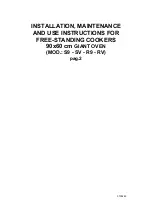
22
Tested for you in our cooking studio.
Here you will find a selection of dishes and the ideal settings for
them. We will show you which type of heating and which
temperature are best suited for your dish. You can find
information about suitable accessories and the height at which
they should be inserted. There are also tips about cookware
and preparation methods.
Notes
■
The values in the table apply to dishes placed into the
cooking compartment when it is cold and empty.
Only preheat the appliance if the table specifies that you
should do so. Line the accessories with greaseproof paper
before preheating.
■
The times specified in the tables are guidelines only. They will
depend on the quality and composition of the food.
■
Use the accessories supplied. Additional accessories may be
obtained as special accessories from specialist retailers or
from the after-sales service.
Before using the appliance, remove all accessories from the
cooking compartment that you will not be using.
■
Always use oven gloves when taking hot accessories or
ovenware out of the cooking compartment.
■
Your oven is suitable for baking on one level.
Caution!
The appliance was manufactured to suit the reference gases
specified in the standards. If a gas is used which does not
comply with the specified gas mixture and pressure, cooking
performance and heat output may not produce the desired
result.
Cakes and pastries
Cake tins
When you are baking in the cake tin, insert the wire rack at the
level indicated and place the cake tin on the wire rack.
Dark-coloured cake tins are the most suitable.
If you use light-coloured baking tins or glass, the baking time
increases and the cake is not browned evenly.
Only use heat-resistant glass dishes. Do not place a hot glass
dish on a cold or wet surface. The glass could break.
If you want to use silicone moulds, follow the guidelines in the
manufacturer's instruction manual. Silicone moulds turn out
slightly smaller than normal cake tins. For this reason, the
quantities may be slightly different to those indicated in your
recipe.
Baking tables for the lower burner in the gas oven
In the tables, you will find the optimum types of heating for a
selection of cakes and gateaux. The temperature and cooking
times depend on the quantity and consistency of the dough.
The values in the table apply to dishes placed into the cooking
compartment when it is cold and empty.
The heat is distributed in the oven as soon as the gas escaping
from the lower gas burner is ignited. For this reason, the
underside of food is usually more browned than the top.
Name of the gas
Gas mixture (%)
G20
CH
4
= 100
G25
CH
4
= 86, N
2
= 14
G30
n-C
4
H
10
= 50, i-C
4
H
10
= 50
Cake in a mould
Accessories
Level
Temperature in
°C
(lower gas
burner on the
oven)
Cooking time
in minutes
Cakes
Round springform cake tin with tube
sheet, deep
2
180
60-80
Cakes
Round springform cake tin with tube
sheet, wide
3
180
60-80
Sponge cake
Springform cake tin (dia. 26 cm)
2
180
50-60
Apple pie
Springform cake tin, light (dia. 20 cm)
2
230
60-80
Semolina cake
Glass ovenproof dish, rectangular
3
180
60-80
Several small baked items on the bak-
ing sheet
Accessories
Level
Temperature in °C
(lower gas burner on
the oven)
Cooking time in min-
utes
Small cakes
Baking sheet
4
170
70-90
Biscuits
Baking sheet
3
180
40-60
Sesame seed rings
Baking sheet
4
190
60-80
Puff pastry strudel
Baking sheet
4
180
50-70
Yufka dough strudel
Baking sheet
3
190
60-80
Yeast-risen pastry
Baking sheet
4
170
70-90
Pizza
Baking sheet
3
190
50-70
Summary of Contents for HGA233120I
Page 1: ... en Instruction manual Free standing cooker HGA233120I ...
Page 2: ......
Page 25: ......
Page 26: ......
Page 27: ......







































